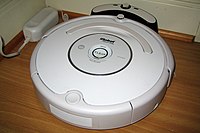Product design: Difference between revisions
→References: source does not offer much information but seems to be a promotional page for a product design company |
|||
| Line 20: | Line 20: | ||
==External links== |
==External links== |
||
* [http://www.iddsummit.org/ The International Development Design Summit] - designing "products" for [[developing world]] |
* [http://www.iddsummit.org/ The International Development Design Summit] - designing "products" for [[developing world]] |
||
*[http://www.embedded.com.au Embedded Ltd - designers of high-reliability electronics for commercial products] |
|||
==References== |
==References== |
||
Revision as of 13:09, 4 August 2009

Product design can be defined as the idea generation, concept development, testing and manufacturing or implementation of a physical object or service. Product Designers conceptualize and evaluate ideas, making them tangible through products in a more systematic approach. The role of a product designer encompasses many characteristics of the marketing manager, product manager, industrial designer and design engineer.
The term is sometimes confused with industrial design, which defines the field of a broader spectrum of design activities, such as service design, systems design, interaction design as well as product design.[citation needed] The role of the product designer combines art, science and technology to create tangible three-dimensional goods. This evolving role has been facilitated by digital tools that allow designers to communicate, visualize and analyze ideas in a way that would have taken greater manpower in the past.
Skills needed
Product designers are equipped with the skills needed to bring products from conception to market. They should have the ability to manage design projects, and subcontract areas to other sectors of the design industry. Aesthetics is considered important in Product Design but designers also deal with important aspects including technology, ergonomics, usability, stress analysis and materials engineering.
As with most of the design fields the idea for the design of a product arises from a need and has a use. It follows a certain method and can sometimes be attributed to more complex factors such as association and telesis. Also used to describe a technically competent product designer or industrial designer is the term Industrial Design Engineer. The Cyclone vacuum cleaner inventor James Dyson for example could be considered to be in this category (see his autobiography Against The Odds, Pub Thomson 2002).
Application
Some companies focus more on product design than others. Technology-driven companies like iRobot, Google or Nokia use product design to achieve a competitive edge, and therefore see employees with exceptional product design skills as strategic assets.
See also
External links
- The International Development Design Summit - designing "products" for developing world
- Embedded Ltd - designers of high-reliability electronics for commercial products
